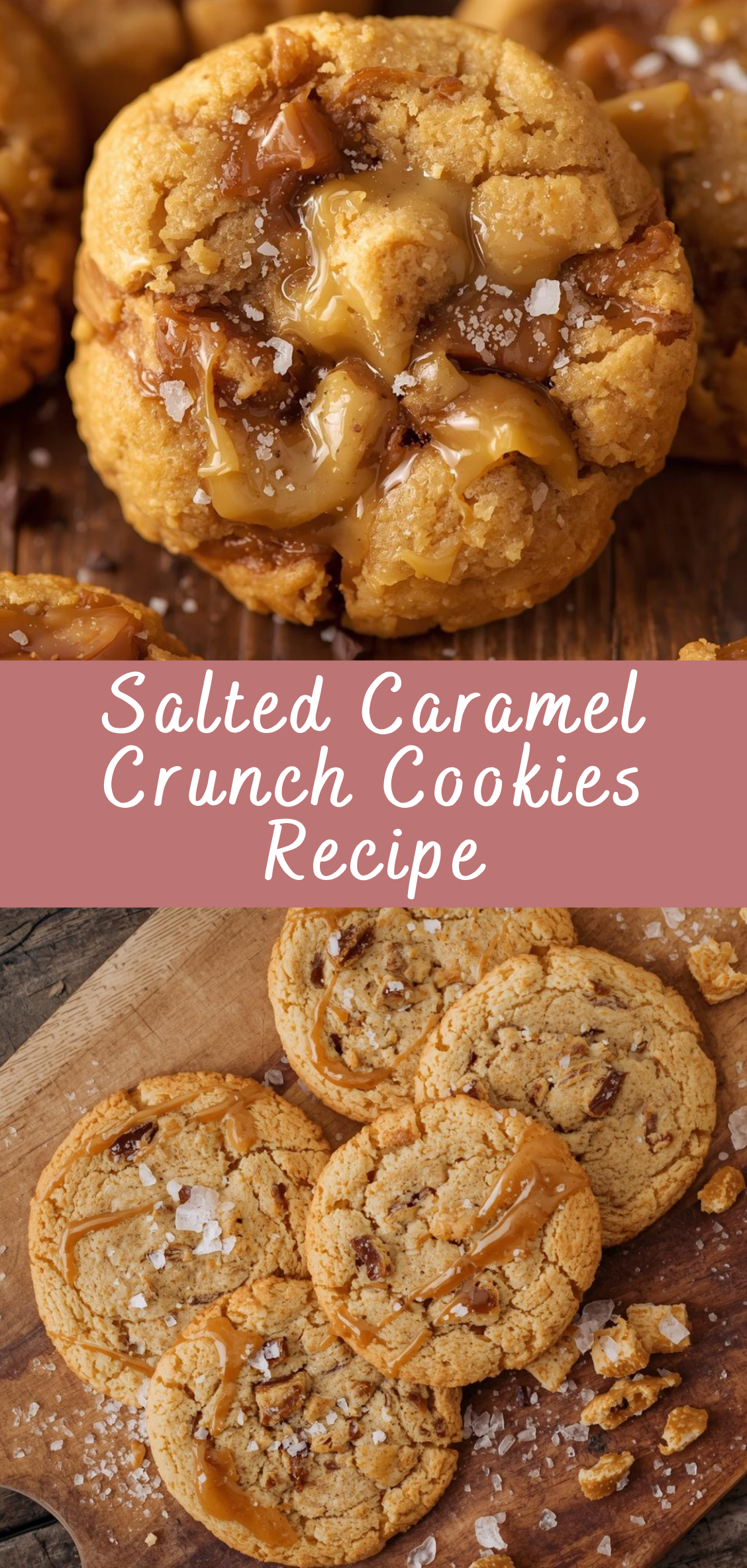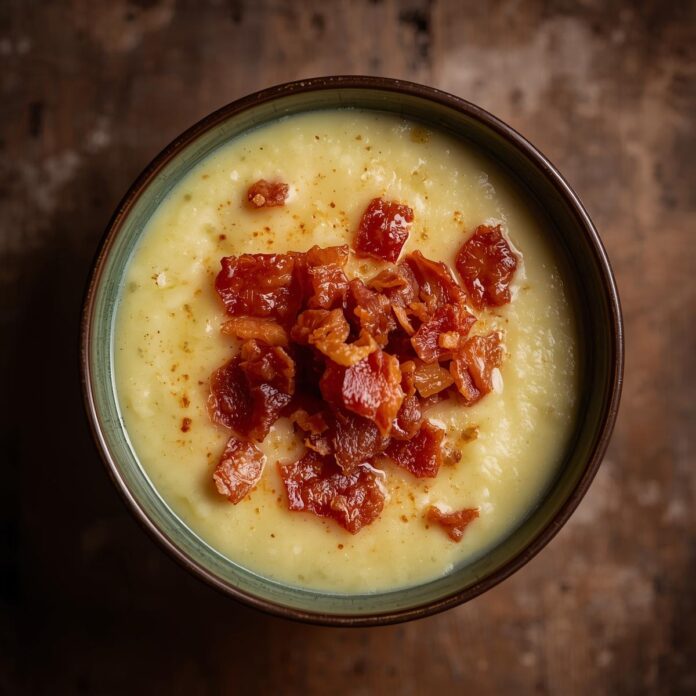Salted Caramel Crunch Cookies: A Symphony of Sweet, Salty, and Irresistible Texture
Few flavor combinations captivate the senses quite like salted caramel. It is a pairing that bridges opposites—sweet and salty, smooth and crisp, indulgent yet balanced. Now imagine capturing that luxurious harmony in the form of a perfectly baked cookie: golden at the edges, soft in the center, and studded with bites of buttery caramel and satisfying crunch. That is the essence of Salted Caramel Crunch Cookies—a confection that celebrates contrast and comfort in every bite.

Salted caramel as a concept may seem modern, but its roots stretch deep into the history of confectionery. The marriage of sugar and salt has long been understood by chefs and pastry artisans as a way to enhance flavor complexity. In Brittany, France, where the famous caramel au beurre salé (salted butter caramel) originated, this culinary revelation emerged from the region’s use of rich, salted butter in sweets. What began as a regional delicacy soon swept across the world, becoming a beloved flavor profile in desserts ranging from ice cream to chocolate bars—and, naturally, cookies.
The magic of salted caramel lies in its duality. Sugar, when melted and caramelized, transforms into something deeper and more nuanced than mere sweetness. It develops layers of bitterness, nuttiness, and warmth. A touch of salt then amplifies these notes, awakening the palate and cutting through richness with a sharp, savory edge. When folded into cookie dough—rich with butter, brown sugar, and vanilla—the result is a treat that feels both nostalgic and decadent, evoking childhood memories of caramel candies while satisfying a sophisticated adult craving for balanced sweetness.
This recipe takes that balance even further by introducing crunch—small, crisp inclusions that provide textural excitement. That crunch can come from toffee bits, caramelized sugar shards, crushed pretzels, or even puffed rice coated in caramel. Each variation contributes its own charm, turning a simple cookie into an experience of contrasts: soft and chewy interiors, crisp edges, and scattered pockets of golden caramel that stretch just slightly when warm.
But beyond its irresistible flavor and texture, the Salted Caramel Crunch Cookie carries emotional weight. Baking these cookies fills the kitchen with the aroma of browned butter, melting sugar, and toasted sweetness—a scent that feels like comfort itself. The first bite, with its combination of buttery crumb and molten caramel, has a way of silencing the world for a moment. It’s not just dessert—it’s a pause, a pleasure, a little act of kindness you can bake for yourself or share with others.
In this recipe, we will walk through every step of creating the perfect Salted Caramel Crunch Cookie, from crafting homemade caramel bits to achieving that ideal chewy texture. You’ll learn the science behind caramelization, the role of each ingredient in achieving structure and balance, and how to customize the recipe to your taste. Whether you’re an experienced baker or a home cook looking for a new signature cookie, this guide will help you master the nuances that make these cookies unforgettable.
What makes these cookies truly special is their versatility. They can be elegant enough for a holiday dessert platter yet casual enough for a cozy afternoon snack. You can drizzle them with extra salted caramel for a show-stopping presentation or sandwich them around ice cream for an indulgent twist. They’re the kind of treat that disappears quickly from the cookie jar and lingers fondly in memory.
At its heart, the Salted Caramel Crunch Cookie embodies the essence of baking itself: transformation through heat, balance through contrast, and joy through sharing. It’s a reminder that great desserts don’t just feed the body—they evoke emotion, create nostalgia, and connect us through simple pleasures.
Detailed Instructions: How to Make Salted Caramel Crunch Cookies
There’s something alchemical about baking cookies—the transformation of butter, sugar, and flour into a form that feels greater than the sum of its parts. In this recipe, we elevate that alchemy with the deep, golden richness of caramel and the sparkle of salt. Every element has a role to play, and when handled with intention, they yield cookies that are tender, crisp-edged, and full of nuanced flavor.
Step 1: Gather and Prepare Your Ingredients
Before you begin, ensure that all ingredients are fresh, measured accurately, and at room temperature. Baking is both science and art; precise measurements and controlled temperatures make all the difference.
You’ll need:
-
2 ¼ cups (280 g) all-purpose flour
-
½ teaspoon baking soda
-
½ teaspoon baking powder
-
½ teaspoon fine sea salt
-
¾ cup (170 g) unsalted butter, softened
-
¾ cup (150 g) packed light brown sugar
-
½ cup (100 g) granulated sugar
-
1 large egg + 1 egg yolk, room temperature
-
2 teaspoons pure vanilla extract
-
1 cup (150 g) caramel bits or chopped soft caramel candies
-
½ cup (80 g) toffee bits or caramelized crisp rice for crunch
-
½ teaspoon flaky sea salt (for topping)
-
Optional: 1 tablespoon milk or cream, if dough feels dry
Ingredient Insights:
-
Butter: Unsalted butter gives you control over the salt level and contributes richness. Softened butter creams more effectively with sugar, creating a smooth, airy dough that results in tender cookies.
-
Brown Sugar: Adds moisture and a deep molasses flavor that complements the caramel notes.
-
Egg + Egg Yolk: The whole egg binds ingredients, while the extra yolk enhances chewiness and richness.
-
Vanilla: Adds aroma and rounds out sweetness. A high-quality vanilla extract (or even vanilla bean paste) makes a remarkable difference.
-
Caramel Bits: Store-bought caramel bits are convenient, but you can also chop soft caramels into small pieces or make homemade caramel shards (instructions below).
-
Crunch Element: Toffee bits give a buttery crackle. Crushed pretzels add salt and crunch. For a playful twist, use caramelized puffed rice or candied nuts.
Step 2: Make or Prepare the Caramel Components
If using store-bought caramel bits or toffee, skip ahead to Step 3.
But for a truly luxurious result, you can craft your own homemade caramel crunch.
Homemade Caramel Crunch (Optional):
-
In a small heavy-bottomed saucepan, combine ½ cup (100 g) sugar with 2 tablespoons water.
-
Heat over medium flame without stirring until the sugar dissolves and begins to turn amber. You can swirl the pan gently to promote even color.
-
Once the caramel reaches a deep golden hue (around 340°F / 170°C), pour it carefully onto a sheet of parchment paper or a silicone baking mat.
-
Allow it to cool and harden completely—about 10 minutes—then break it into small shards or crush with a rolling pin.
These shards will create crisp, glassy pockets of caramel that melt slightly into the dough as it bakes, offering the perfect “crunch” in every bite.
Step 3: Cream the Butter and Sugars
In a large mixing bowl, combine the softened butter, brown sugar, and granulated sugar.
Using a hand mixer or stand mixer fitted with a paddle attachment, beat on medium speed for 2–3 minutes until the mixture is fluffy, pale, and aerated.
This step is critical. Creaming incorporates air, which not only lightens the texture but also helps the cookies spread properly. You’ll notice the mixture turn lighter in color as sugar crystals cut tiny air pockets into the butter.
Scrape down the sides of the bowl midway to ensure even mixing.
Step 4: Incorporate the Wet Ingredients
Add the egg, egg yolk, and vanilla extract to the butter-sugar mixture. Beat until fully combined and glossy, about 1 minute.
The additional egg yolk enriches the dough and contributes a chewy, almost fudgy interior once baked.
If the mixture looks slightly broken or greasy at this stage, don’t worry—it will smooth out once you add the dry ingredients.
Step 5: Combine the Dry Ingredients
In a separate bowl, whisk together the flour, baking soda, baking powder, and salt. Whisking aerates the flour and evenly distributes the leavening agents, preventing uneven texture.
Gradually add the dry mixture to the wet ingredients in two or three additions, mixing on low speed just until combined. Do not overmix, as this can toughen the dough and result in dense cookies.
The dough should be soft but not sticky. If it feels dry or crumbly, add 1 tablespoon of milk or cream to bring it together.
Step 6: Fold in the Caramel and Crunch Components
Using a spatula or wooden spoon, gently fold in the caramel bits and crunchy additions.
This step is best done by hand to prevent overworking the dough and breaking the caramel pieces.
You want even distribution so that each cookie holds a balance of gooey caramel, sweet crunch, and buttery dough.
If the caramel pieces are very soft, you can briefly chill them beforehand to make folding easier.
Step 7: Chill the Dough
This step separates good cookies from great cookies.
Cover the mixing bowl with plastic wrap and refrigerate for at least 1 hour, or ideally overnight.
Chilling allows the flour to hydrate and the butter to firm up, leading to better flavor development and thicker cookies that spread evenly during baking.
If you’re in a rush, even a 30-minute chill will make a noticeable difference—but the longer rest produces deeper caramel flavor and more defined texture.
Step 8: Preheat and Prepare for Baking
About 15 minutes before baking, preheat your oven to 350°F (175°C).
Line two large baking sheets with parchment paper or silicone mats.
Using a medium cookie scoop or tablespoon, portion the dough into balls roughly 1½ tablespoons each. Roll them lightly between your palms for a uniform shape and place them 2 inches apart on the prepared sheets to allow room for spreading.
If desired, sprinkle each cookie ball with a pinch of flaky sea salt before baking. This enhances the salted caramel character and creates a visually appealing finish.
Step 9: Bake to Perfection
Bake the cookies in the preheated oven for 10–12 minutes, or until the edges are golden brown but the centers still appear slightly soft and underbaked.
Remember: cookies continue to cook as they cool on the baking sheet.
For evenly baked cookies, rotate the pans halfway through baking. If your oven tends to brown unevenly, bake one sheet at a time in the center rack.
You’ll know they’re ready when the caramel bits bubble slightly and the tops have a faint crackle. The aroma at this stage—brown sugar mingling with caramel and butter—is intoxicating.
Step 10: Cooling and Setting
Once baked, remove the trays from the oven and allow the cookies to rest on the baking sheet for 5 minutes.
This gives the caramel time to set slightly and prevents breakage when transferring.
Then, carefully move the cookies to a wire rack to cool completely.
If you’d like a bakery-style presentation, you can press a few extra caramel or toffee bits into the tops while still warm.
As they cool, the cookies firm up at the edges while remaining soft and chewy in the center—the hallmark of a perfect texture balance.
Step 11: Presentation and Finishing Touches
To finish, lightly sprinkle a few flakes of sea salt over the cooled cookies. The salt crystals catch the light and provide a sharp contrast to the buttery sweetness.
For an elevated version:
-
Drizzle with warm caramel sauce for extra indulgence.
-
Dip half of each cookie in melted chocolate and sprinkle with crushed toffee.
-
Sandwich two cookies around a scoop of vanilla ice cream for an unforgettable dessert.
Serve warm for gooey caramel strands or at room temperature for a firm, chewy texture.
Step 12: Baking Science – Why These Cookies Work
Understanding why this recipe succeeds helps you replicate (and even improve) it.
-
The Creaming Step incorporates air, which leads to better spread and texture.
-
Brown Sugar attracts moisture, ensuring a chewy interior.
-
Extra Egg Yolk adds richness and emulsifies fats.
-
Chilling solidifies butter, slowing spread and intensifying flavor.
-
Salt Balance heightens caramel’s complexity, creating depth rather than just sweetness.
Each element plays a role in constructing the perfect salted caramel cookie—where every bite reveals a new layer of taste and texture.
Salted Caramel Crunch Cookies Recipe
Ingredients
- 2 ¼ cups (280 g) all-purpose flour
- ½ tsp baking soda
- ½ tsp baking powder
- ½ tsp salt
- ¾ cup (170 g) unsalted butter, softened
- ¾ cup (150 g) brown sugar, packed
- ½ cup (100 g) granulated sugar
- 1 large egg
- 1 large egg yolk
- 2 tsp pure vanilla extract
- 1 cup (170 g) caramel bits or chopped soft caramels
- 1 cup (160 g) toffee bits (like Heath or Skor pieces)
- Flaky sea salt, for topping
Instructions
- Preheat oven to 350°F (175°C). Line two baking sheets with parchment paper or silicone mats.
- Mix dry ingredients:
In a medium bowl, whisk together flour, baking soda, baking powder, and salt. Set aside. - Cream butter and sugars:
In a large bowl (or stand mixer), beat together butter, brown sugar, and granulated sugar until light and fluffy — about 2–3 minutes. - Add eggs and vanilla:
Beat in the egg, then the egg yolk, followed by the vanilla extract until fully incorporated. - Combine dry and wet:
Gradually mix in the dry ingredients until just combined — do not overmix. - Add the mix-ins:
Stir in the caramel bits and toffee pieces until evenly distributed. - Chill the dough (optional):
For thicker cookies with more caramel crunch, chill the dough for 30 minutes. - Scoop and bake:
Scoop tablespoon-sized balls of dough onto the prepared baking sheets, leaving about 2 inches of space between each.
Bake for 12–14 minutes, or until the edges are golden and centers still look slightly soft. - Finish with salt:
Immediately after removing from the oven, sprinkle the tops lightly with flaky sea salt. - Cool:
Allow cookies to cool on the pan for 5 minutes, then transfer to a wire rack to cool completely.
Notes
- Caramel bits: Kraft caramel bits work perfectly — they hold their shape better than soft caramels.
- Toffee swap: If you don’t have toffee bits, crushed hard caramel candies also work.
- Extra gooey: Drizzle with melted caramel or dip half in chocolate for an indulgent twist.



